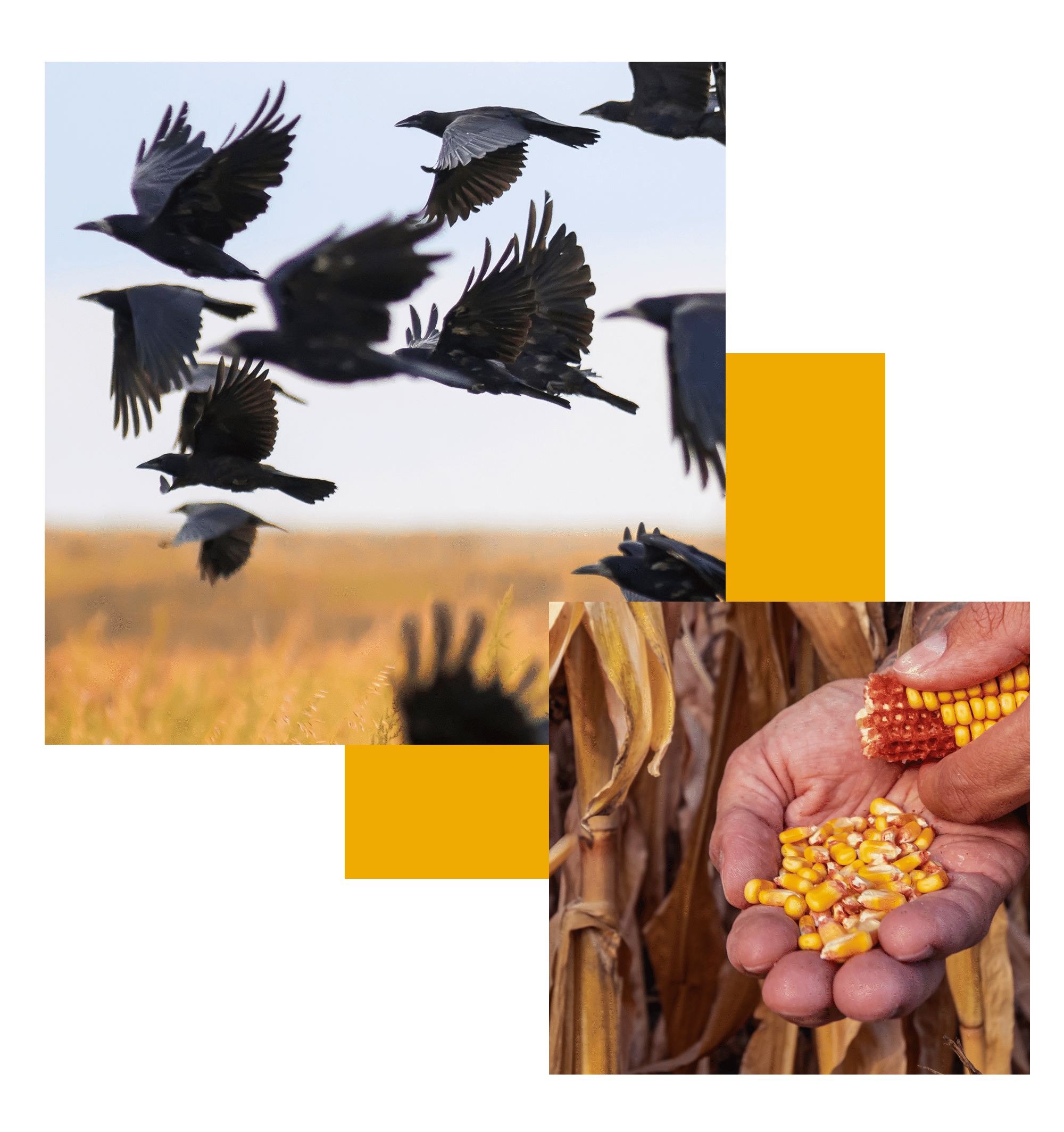birds known to destroy

1M+
acres of field and sweet corn every year
before the crop can even emerge.
Avipel is the ultimate corn seed treatment and the first scientifically proven corn seed treatment to stop birds from eating newly planted seed in your clients fields.
Avipel is made from an organic plant-based organic chemical that can help result in greater corn crop yields on your clients’ farms.
Bird damage to planted corn, sunflower, canola and rice seed is increasing across the United States. National statistics on the damage is not tracked by the National Agricultural Statistics Service (NASS) or other government agency because birds have not been classified as an agricultural pest. Certain species are used instead as monitors for pesticide safety by regulatory bodies. As a result of the extensive testing done on birds, several well-known pesticides used to control insects have been removed from use because of avian toxicity. (Measurol, Furadan, Lindane.)

1M+
before the crop can even emerge.
Bird populations are increasing, with pest birds having more of an impact, wildlife experts report. Throughout the United States, birds have been cited in destroying more than 1 million acres of field and sweet corn annually before the crop even has the opportunity to emerge.
Corn is particularly vulnerable to bird populations because it is planted during a time when other food sources are limited. Moreover, this planting season comes at the same time as birds are preparing for migration and breeding season in many regions throughout the United States. When a flock discovers corn seed—known to be a highly desirable nourishment source—it can raid your clients’ fields for precious corn seed.

Birds tend to target corn seed as a source of nutrition and calories because they use the starch from corn for egg production. With breeding couples eating together, male birds consume the same food sources as female mates. Most birds consume about 200 seeds daily.
Avipel is a safe and effective corn seed treatment option designed to help corn growers stave off bird damage. This bird repellent prevents blackbirds, boat-tailed grackles, crows, European starlings, grackles, pheasants, red-wing blackbirds, ring-neck pheasants, sandhill cranes, starlings and turkeys from targeting and eating planted corn seeds. Avipel is offered to crop advisors as a liquid application.
Avipel is nonsystemic to corn, nonlethal to birds and nontoxic to plants and fish. It is endorsed by the International Crane Foundation and has been shown to cause no side effects that could be costly. Moreover, Avipel corn seed treatment also causes no groundwater contamination, providing peace of mind to growers that their aquifers and wells will remain safe with use.
Avipel’s active ingredient is 9,10-anthraquinone (AQ), which is an organic chemical found in many plant species, including aloe vera. The active ingredient causes a gut reaction without harming birds, whose flocks quickly learn to avoid seeds treated with Avipel and begin foraging for other food, helping your clients’ cornfields remain fully protected. Avipel works throughout the vulnerable period, lasting as long as 30 days after planting, in which seed kernel remnants remain as a source of food.

Several states have monitored significant changes in bird damage. Wisconsin, for example, observed a direct correlation between increased corn field damage due to cranes with the loss of lindane from use as an insecticide treatment. Crane populations also continue to grow as a result of aggressive restoration of breeding flocks and habitat.
Cranes are now back in newly planted corn fields in Wisconsin that are within 1½ kilometers of a wetland where reports of 20 percent or more of the crop is destroyed. Of the 3½ million acres of corn planted in Wisconsin, 2.7 million acres are within cranes’ potential feeding range.
South Dakota is dealing with a pheasant population that continues to grow in connection with successful habitat restoration. The cropland reserve program has set aside significant land areas adjacent to corn fields. Cover and nesting sites have been provided in the process, and with the loss of lindane and measurol, there is no longer an effective way to keep planted corn seed off the pheasant’s menu.
Early spring does not offer birds much dietary diversity, and the liquid starch found in corn seed is essential to birds’ reproductive health. In 2008, about 20 percent of South Dakota’s cornfields had noticeable bird damage that could vary from 5 percent to even more than 50 percent stand loss. Replanting in the Dakotas is a risky venture because of its short season. The economic impact of reduced stand is compounded by the necessity for additional weed control as well as yield loss.
Juvenile and subadult cranes in a marauding flock feed heavily in early morning and early evening.

Mississippi has increased corn acreage substantially recently at the expense of cotton. With more than 750,000 acres in corn, migrating blackbirds, grackles, crows and cowbirds have found corn seed to be a very attractive starch source for the energy needed during the migration north. The narrow planting window in the Delta region is perfectly timed for the spring migration, and losses to bird damage have now been estimated by the state to be high.
Twenty-five percent of planted corn is experiencing between 10 and 15 percent stand loss, and 5 percent of corn is experiencing greater than 25 percent stand loss. Tillage practices plus narrow planting timing work against any replanting in Mississippi, so crop yield is directly affected. As in South Dakota, increased weed control adds to the input cost of fields experiencing bird depredation.
State
Bird Species
Affected Acres %
Stand Loss %
Replant Cost Per Acre
Mississippi
Blackbird, Cowbird, Crow, Grackle, Starling
25%
5%
10 to 15%
>25%
$100 to $12
South Dakota
Pheasant
15 to 20%
8 to 10%
$50
Wisconsin
Crane
74%
5 to 20%
$50
More attention was paid to bird damage to fields planted with corn, rice, sunflower, canola, sorghum and other cereal grains in 2010. Identification of damage caused by birds compared with rodents can be difficult to differentiate, however.

Arkion Life Sciences has researched and developed bird repellency products for more than a decade in the lab and in the field and is Avipel’s manufacturer. Avipel studies conducted by the USDA along with other organizations have shown the corn seed treatment’s efficient protection of corn seed.
Avipel is sold by local agriculture retailers and corn seed suppliers. Contact your local Avipel representative to learn more about purchasing Avipel so you can start protecting your corn crop with the ultimate bird repellent.
Crop advisors wanting to learn more about Avipel, including avian depredation to planted cereal crops, can review application guides, independent research studies, USDA state-specific labels and more information.